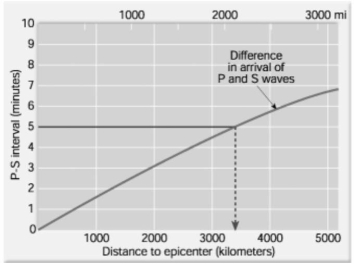Correct Answer

verified
Correct Answer
verified
True/False
The mantle is composed mainly of metallic iron with small amounts of magnesium silicate minerals.
Correct Answer

verified
Correct Answer
verified
Multiple Choice
The average composition of the continental crust most closely approximates that of ________.
A) granite
B) basalt
C) peridotite
D) iron
Correct Answer

verified
Correct Answer
verified
Multiple Choice
The instrument that records earthquake events is termed a ________.
A) polygraph
B) thermograph
C) seismograph
D) barograph
Correct Answer

verified
Correct Answer
verified
Multiple Choice
Which one of the following statements about the crust is NOT true?
A) It is the thinnest of the major subdivisions.
B) It is thickest where prominent mountains exist.
C) Oceanic crust is enriched in potassium, sodium, and silicon.
D) Continental rocks are compositionally different than oceanic rocks.
Correct Answer

verified
Correct Answer
verified
True/False
S waves can travel through solid and liquid media.
Correct Answer

verified
Correct Answer
verified
Multiple Choice
The Earth's magnetic field originates by ________.
A) weak electrical currents associated with hot, rising, mantle plumes
B) magnetic mineral grains in the inner core
C) weak electrical currents associated with fluid motions in the outer core
D) magnetization of oxygen and nitrogen atoms in the atmospheric ozone layer by solar radiation
Correct Answer

verified
Correct Answer
verified
Short Answer
Using the time-travel graph below, how long does it take a P wave to travel 2000 km? 
Correct Answer

verified
Correct Answer
verified
Multiple Choice
On a typical seismogram, ________ will show the highest amplitudes.
A) P waves
B) S waves
C) surface waves
D) body waves
Correct Answer

verified
Correct Answer
verified
Multiple Choice
The asthenosphere is located ________.
A) within the crust
B) in the upper mantle
C) between the mantle and outer core
D) within the outer core
Correct Answer

verified
Correct Answer
verified
Multiple Choice
The distance between a seismological recording station and the earthquake source is determined from the ________.
A) earthquake magnitude
B) intensity of the earthquake
C) length of the seismic record
D) arrival times of P and S waves
Correct Answer

verified
Correct Answer
verified
Multiple Choice
The record of an earthquake obtained from a seismic instrument is a(n) ________.
A) seismograph
B) seismogram
C) time-travel graph
D) epigraph
Correct Answer

verified
Correct Answer
verified
Multiple Choice
The elastic rebound theory for the origin of earthquakes was first proposed by ________ following the ________ earthquake.
A) Reid; 1906, San Francisco
B) Giuseppe; 1925, Pizza Lake
C) Richter; 1989, Loma Prieta
D) Mohorovicic; 1964, Anchorage
Correct Answer

verified
Correct Answer
verified
Short Answer
The ________ is the site of initial rupturing associated with an earthquake.
Correct Answer

verified
Correct Answer
verified
Multiple Choice
The average composition of the oceanic crust is thought to approximate that of ________.
A) granite
B) basalt
C) peridotite
D) iron
Correct Answer

verified
Correct Answer
verified
Multiple Choice
The ________ earthquake was accompanied by extensive fire damage.
A) Anchorage, 1964
B) San Francisco, 1906
C) Mexico City, 1985
D) Yerevan, Armenia, 1988
Correct Answer

verified
Correct Answer
verified
True/False
The Richter earthquake magnitude scale is based on the total amount of energy released by the earthquake.
Correct Answer

verified
Correct Answer
verified
Multiple Choice
Word Analysis. Examine the words and/or phrases for each question below and determine the relationship among the majority of words/phrases. Choose the option which does not fit the pattern.
A) Modified Mercalli
B) energy
C) Richter
D) amplitude
Correct Answer

verified
Correct Answer
verified
Multiple Choice
Which one of the following best characterizes tsunamis?
A) They cause the land to ripple and oscillate.
B) They are faster than seismic surface waves.
C) They have relatively small amplitudes compared to their very long wavelengths.
D) They are easily seen at sea but are lost in the swell and breaking waves along a coast.
Correct Answer

verified
Correct Answer
verified
Multiple Choice
Major earthquakes are often followed by somewhat smaller events known as ________.
A) aftershocks
B) foreshocks
C) tremors
D) hyposhocks
Correct Answer

verified
Correct Answer
verified
Showing 21 - 40 of 62
Related Exams